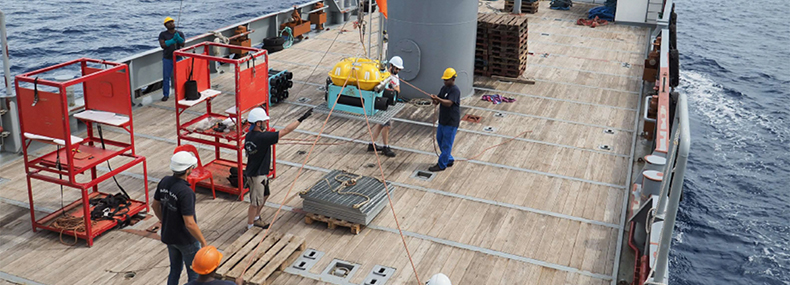Mayotte has been experiencing sustained seismic activity for the past nine months. Despite relatively poor seismological coverage, given the moderate seismicity of the region, BRGM has been monitoring the situation from three seismological stations on the island, supplemented by other regional stations further afield, notably in the Comoros and Madagascar. Analyses carried out by BRGM, IPGP, the École et observatoire des sciences de la Terre (CNRS/Université de Strasbourg) and the Observatoire volcanologique du Karthala (CNDRS1, Grande Comore) have already led to a better interpretation of the seismic signals.
More than 1,600 earthquakes, located 50 km east of Mayotte, have been recorded. Of these, 29 events of magnitude greater than 5 were widely felt by the population of the archipelago and, in places, affected buildings. In addition, low-frequency signals of a different nature, which propagate better over long distances, were recorded by global networks, particularly on November 11th 2018. These signals could correspond to tremor-type earthquakes: imperceptible earthquakes generated by rising magma. In addition, since July 2018, regular processing by IGN’s permanent GNSS network has shown that the six high-precision GPS stations installed on the island of Mayotte have recorded a continuous eastward displacement of around 14 mm/month, associated with a subsidence of 7 mm/month. Taken together, these observations suggest that the current episode could be of the seismic-volcanic type.
A scientific call for tenders to characterise seismo-volcanic processes
At BRGM’s initiative, from the start of the seismo-volcanic episode, the scientific community mobilised to understand the phenomena underway and their evolution. In this context, the CNRS coordinated a call for tenders, co-financed by the Ministry of Ecological Transition and Solidarity. Addressed on November 29th 2018 to more than 20 French research laboratories in this field, it aims to improve observation and scientific understanding of this phenomenon and better estimate the potential hazards and impacts for this French territory. With a budget of 420,000 euros, it will support observation missions by deploying instruments on land and at sea, the data from which will have to be made available to the scientific community without delay. The analysis of these data and the reinforcement of the observation network are also part of this call for tenders.
After an evaluation of the proposals received by the scientific and operational committees, three projects were selected by the steering committee on January 22th 2019. These projects involve 11 laboratories and 44 researchers, teacher-researchers, engineers and technicians from CNRS, IPGP, BRGM, Ifremer and IGN.
On land and at sea: extensive deployment of instruments from late February to summer 2019
- Deployment of seismometers on the seabed. From February 23rd to 27th 2019, a team from the Institut de Physique du Globe de Paris (CNRS/IPGP/Université Paris Diderot) will be deploying six seabed seismometers from the CNRS-IPGP fleet, together with a pressure sensor, on the SGTM cargo ship Ylang. The deployment is scheduled to last six months.
- Deployment of instruments in Mayotte. A team from the École et observatoire des sciences de la Terre (CNRS/Université de Strasbourg) will travel to Mayotte during the week of March 4th to 8th 2019 to install high-precision seismological and GNSS3 stations at sites in the communes of Mtsamboro (north of Grande-Terre), Kani-Kéli (south of Grande-Terre) and Pamandzi (Petite-Terre). This deployment is being carried out with the support of the BRGM teams in Mayotte and Orléans, and with support from IGN for the recovery and dissemination of GNSS information.
- Installation of a new geophysical station in the Glorieuses Islands. The Piton de la Fournaise volcanological observatory (OVPF-IPGP) has scheduled a reconnaissance of this uninhabited archipelago located between the Comoros and Madagascar and the installation of a seismic station on March 13th and 14th 2019 during an army rotation. A second operation to install remote transmission and a high-precision GNSS station is scheduled for April 2019.
An oceanographic campaign is currently being discussed with Ifremer, the Ministry of Ecological Transition and Solidarity and the Ministry of Higher Education, Research and Innovation, to observe the seabed and detect and quantify any degassing linked to an underwater volcano. It could take place this spring or summer.
In addition to the deployment of instruments, a team from the University of Reunion in association with the OVPF-IPGP will be carrying out field missions to consolidate our knowledge of the tectonic and volcanic history of Mayotte: highlighting the island’s tectonic structures, dating magmatic rocks and analysing the composition of soil gases. The various teams visiting the field will analyse the data and carry out modelling. The IGN’s permanent GNSS network team will focus on recovering and disseminating all the information from GNSS for the whole community.
To find out more, click here:









